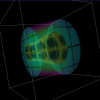Free Online Productivity Tools
i2Speak
i2Symbol
i2OCR
iTex2Img
iWeb2Print
iWeb2Shot
i2Type
iPdf2Split
iPdf2Merge
i2Bopomofo
i2Arabic
i2Style
i2Image
i2PDF
iLatex2Rtf
Sci2ools
VIS
2004
IEEE
2004
IEEE
Rendering Implicit Flow Volumes
Traditional flow volumes construct an explicit geometrical or parametrical representation from the vector field. The geometry is updated interactively and then rendered using an unstructured volume rendering technique. Unless a detailed refinement of the flow volume is specified for the interior, information inside the underlying flow volume is lost in the linear interpolation. These disadvantages can be avoided and/or alleviated using an implicit flow model. An implicit flow is a scalar field constructed such that any point in the field is associated with a termination surface using an advection operator on the flow. We present two techniques, a slice-based three-dimensional texture mapping and an interval volume segmentation coupled with a tetrahedron projection-based renderer, to render implicit stream flows. In the first method, the implicit flow representation is loaded as a 3D texture and manipulated using a dynamic texture operation that allows the flow to be investigated inter...
Related Content
| Added | 05 Nov 2009 |
| Updated | 05 Nov 2009 |
| Type | Conference |
| Year | 2004 |
| Where | VIS |
| Authors | Daqing Xue, Caixia Zhang, Roger Crawfis |
Comments (0)

